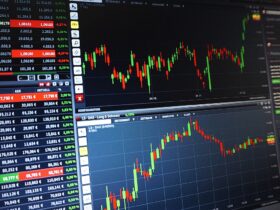According to the Bloomberg report on digital assets, another big fall in the U.S stock market could cause Ethereum’s native token Ether ( ETH) to experience a similar downturn.
Ethereum is at risk of global recession
Mike McGlone is the Bloomberg Intelligence senior commodity strategist. He expects U.S. stocks to be under pressure from the ongoing energy price spikes, and their potential to incite a 2008-like global market depression.
stated that “The war in Ukraine” and “spiking crude” make for a powerful combination for a global depression. He also suggested that top cryptocurrency like Bitcoin and Ether might be subject to initial pressures.
WTI crude oil weekly price chart. Source: TradingView
The correlations between U.S. stockindices and the top cryptocurrencies has only increased in the current global market turmoil and Ukraine-Russia conflict.
Particularly, Ether’s correlation with tech-heavy Nasdaq100 rose from 0.93 to 0.93 just four days after Russia invaded Ukraine. However, it has since returned to 0.67. A value of 1 indicates that the assets work perfectly together.
ETH/USD daily price chart featuring its correlation with Nasdaq 100. Source: TradingView
McGlone spotted Ether trading at the middle of a range that was defined by its 100-week exponentially moving average (100-day EMA, the red wave in chart below) at $6,000 and its 30-week EMA(the green wave) at near $2,000. McGlone expects substantial selling pressure at the interim resistance of $4,000.
ETH/USD weekly price chart. Source: Bloomberg Intelligence
The strategist said that Ethereum was “about the middle” of the range and stated that “if the stock markets take another leg lower, Ethereum will more likely to return to the lower end” at $2,000. He also added:
“If equities fall fast, Ethereum could repeat the last summer and revisit $1,700.”
Record lows in Ethereum TVL shares
According to the latest data, Ethereum is losing ground to cardano (ADA), Solana(SOL), Avalanche/AVAX and Terra (LUNA) in terms of market dominance.
According to DeFi Llama data, the share of total value locked (TVL), on Ethereum, fell below 55%. This is its lowest record level, and it was 97% at the beginning of 2021.
Share of total value locked by chain. Source: Defi Llama, Galaxy Digital Research
Tom Dunleavy is a researcher at Messari. He notes that the new layer-one blockchains are “faster, more affordable, or offer a more attractive reward system” than Ethereum.
He does however add that it would be difficult to completely overtake Ethereum and Ethereum Virtual Machine, a platform for creating decentralized apps (DApps), due to the first-mover advantage.
Dunleavy added:
“Even rivals like Cardano and Solana have added or are adding EVM compatibility to their products (Terra is a notable exception). The network effects of the EVM have made it a common feature in many cases.
However, most , the so-called “Ethereum murderers”, have fared much worse in 2022, except Terra, when they were faced with energy crises, geopolitical conflicts and rate rise risks.
Solana’s and Cardano’s respective prices dropped more than 50% year to date, compared with Ether who saw a 30% decline in their prices. The Avalanche’s price fell by 37% during the same period.
Ethereum can it regain market share
However, not everyone believes that Ethereum’s TVL market share will continue to fall. GlobalBlock analyst Marcus Sotiriou predicts that Ethereum will regain dominance when it switches to proof of stake later in the year from its current proofs-of-work protocol.
He explained to Business Insider that this was because it would dramatically lower the cost of transactions on Ethereum, which is the main drawback currently facing Ethereum. Ethereum currently works with a surge-pricing system, which results in highly volatile transaction fees.
The network went through a “London hard fork” in August 2021 that used a key EIP-1559 protocol. The EIP-1559 permits the Ethereum protocol, to burn gas fees. This means that some of Ether’s supply is permanently out of circulation.
Similar: Buyback and Burn: What does this mean in crypto?
McGlone explained that Bitcoin and Ethereum are still in their early adoption days. There is increasing demand vs declining supply, and associated price implications.”
“Our bias is why we complicate it — unless there’s something unexpected that stops the growth of the emerging technology, prices should go up.”
According to the strategist, Ether’s relationship with the U.S. stock markets will also decline due to “declining relative risks.”
Ethereum volatility vs. the Nasdaq. Source: Bloomberg Intelligence
He stated that the relative risk of the emerging technology/asset is now closer to 3x. This is especially true if war increases stock market volatility and recession risks.
These views and opinions are the author’s and do not necessarily reflect those of Cointelegraph.com. You should do your research before making any investment or trading decision.






Leave a Reply